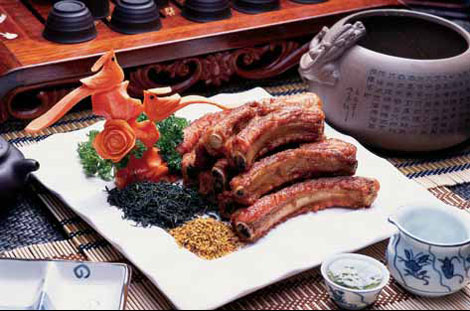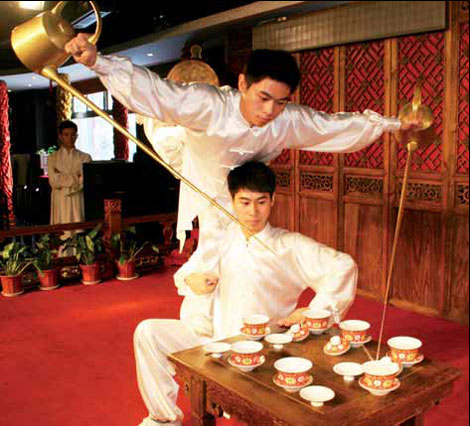Tea's refreshing change
Updated: 2012-05-18 07:52
By Sun Yuanqing (China Daily)
|
||||||||
|
Modern teahouses provide all-round services, including tea-related shopping, drinking, dining and art performances. Photos provided to China Daily |

Chinese beverage takes on renewed meaning and styles to draw in younger generation
Rather than while away their time in coffee shops like most of their peers, Li Jiayi and her friends are happy to spend 1,000 yuan ($158, 122 euros) between them over a pot of tea.
Of course, it is not just a cup or two of tea they get. This regular "ceremony" involves a tea-themed dinner accompanied by tea-related performance art and followed by a tea-oil massage.
"It's not like the old-fashioned teahouse where old folks get a pot of tea and chat all day long. We get all-round service here - shopping for tea, drinking, dining, massages, enjoying art performances. It's a perfect place for friends gathering, and for business banquets," says Li, a 27-year-old company manager in Beijing.
The ancient tea drinking culture, though still popular among the older generation, is making a comeback as it takes on various forms to attract a greater and younger range of customers.
"Tea can be a daily drink or an art form or a relaxing leisure pursuit," says Liu Lei, an industry expert and executive of Xiangguo Teahouse. "At a time when bottled drinks are constantly facing safety issues, tea can be considered a healthy replacement."
Originating in China, tea is deeply rooted in the country's culture and people's lives. It is considered as one of the seven necessities, along with wood, rice, oil, salt, soy sauce and vinegar.
Legend has it that tea was discovered by an emperor, Shennong, about 5,000 years ago, when several tea leaves fell into the water he was boiling under a tree. The refreshing and slightly bitter flavor gradually became popular among the upper classes. By the time of the Tang (AD 618-907) and Song (960-1279) dynasties, it had become the drink for all, and was constantly featured in the works of poets, calligraphers and other artists.
Teahouses sprang up all over the country during the Qing Dynasty (1644-1911), where people could go to eat, drink, play and relax. Teahouse, a famous play written by the legendary Lao She in the 1950s, is set in such an establishment in Beijing and covers the social and cultural changes that took place in the first half of the last century.
Places like Lao She's teahouse may be a thing of the past, but trendy new ones are springing up all over the country, luring in drinkers with more refined and sophisticated tastes.
The right food is important too. Quick and easy dining can be found in places like Chamate, a chain of tea-theme restaurants where people can choose from an extensive menu of drinks and dishes.
Or for those who prefer a private room and a more specialized service, the teahouses on Maliandao, home to Beijing's major tea stores, offer a good choice.
After selecting from the varieties of black and green teas, customers can sip and allow themselves to fuse into the mostly southern-style architectural surroundings, or they can enjoy an appropriate tea-related meal or tea oil massage while artists give performances and demonstrate calligraphy, all to do with tea.
Although Western coffee shop chains such as Starbucks have posed a threat to traditional teahouses, they have also set an example. Gengxiang Teahouse, which has opened 200 stores in China, believes it has thrived due to Western management expertise.
"We consider coffee shops as partners, not competitors, as we specialize in two different areas," says Wang Jun, deputy general manager of Gengxiang. "The business model of Western coffee shops has set a good example for us, especially in scaling operations and instant service."
The popularity of home coffee-making machines has also inspired tea producers, who are now developing machines that brew good quality tea just as quickly.
In other initiatives, tea is used to make dishes and deserts. Tea-flavored ice cream sold by Wuyutai, one of the major tea brands in China, has become a hit with customers.
Tea culture, deeply rooted in southern China, has also evolved through its spread to other regions, where tea production is sparse.
Traditionally, people in the northern part of China prefer flower tea; in East China, it is longjing green tea, and pu'er in Southwest China. But the pattern has changed over the years.
While old Beijingers still prefer their flower tea, young people have developed different tastes. Organic green tea, along with pu'er, black tea and tieguanyin, are some of the varieties that have gained ground over the past decade. And flavors, such as lemon, rose and jujube, that are rarely seen in traditional recipes, have been introduced to appeal to youthful palates.
"Although tea drinking and tea art performance are quite popular in China, they are lacking in ritual, which incorporates tea in people's daily lives, compared with other Asian countries, such as Japan and South Korea," Liu says.
But Li Jiayi and her friends in Beijing fully appreciate their "ritual" teahouse outings as they are.
"Tea ceremonies are more subtle and cultivated than extravagant banquets. They allow people to stop and relax despite the fast pace of modern life," she says.
sunyuanqing@chinadaily.com.cn
(China Daily 05/18/2012 page18)

 Relief reaches isolated village
Relief reaches isolated village
 Rainfall poses new threats to quake-hit region
Rainfall poses new threats to quake-hit region
 Funerals begin for Boston bombing victims
Funerals begin for Boston bombing victims
 Quake takeaway from China's Air Force
Quake takeaway from China's Air Force
 Obama celebrates young inventors at science fair
Obama celebrates young inventors at science fair
 Earth Day marked around the world
Earth Day marked around the world
 Volunteer team helping students find sense of normalcy
Volunteer team helping students find sense of normalcy
 Ethnic groups quick to join rescue efforts
Ethnic groups quick to join rescue efforts
Most Viewed
Editor's Picks

|

|

|

|

|

|
Today's Top News
Chinese fleet drives out Japan's boats from Diaoyu
Health new priority for quake zone
Inspired by Guan, more Chinese pick up golf
Russia criticizes US reports on human rights
China, ROK criticize visits to shrine
Sino-US shared interests emphasized
China 'aims to share its dream with world'
Chinese president appoints 5 new ambassadors
US Weekly

|

|







